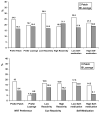Nicotine patch vs. nicotine lozenge for smoking cessation: an effectiveness trial coordinated by the Community Clinical Oncology Program
- PMID: 20004065
- PMCID: PMC2834192
- DOI: 10.1016/j.drugalcdep.2009.11.001
Nicotine patch vs. nicotine lozenge for smoking cessation: an effectiveness trial coordinated by the Community Clinical Oncology Program
Abstract
Background: Nicotine replacement therapies are efficacious for treating nicotine dependence. However, limited data exist on benefits of different NRTs and predictors of treatment outcome. This study compared the effectiveness of transdermal nicotine vs. nicotine lozenge for smoking cessation and identified predictors of treatment response.
Methods: A randomized, open-label effectiveness trial was conducted at 12 medical sites participating in the National Cancer Institute's Community Clinical Oncology Program. The sample consisted of 642 treatment-seeking smokers randomized to 12 weeks of transdermal nicotine or nicotine lozenge.
Results: Smoker characteristics were assessed at baseline, and 24-h point prevalence abstinence confirmed with breath carbon monoxide (CO) was evaluated at end of treatment (EOT) and at a 6-month follow-up. There was a trend for higher quit rates for transdermal nicotine vs. nicotine lozenge at EOT (24.3% vs. 18.7%, p=.10) and 6 months (15.6% vs. 10.9%, p=.10). A logistic regression model of EOT quit rates showed smokers who preferred transdermal nicotine, were not reactive to smoking cues, and did not use nicotine to alleviate distress or stimulate cognitive function had higher quit rates on transdermal nicotine. A logistic regression model of 6-month quit rates showed smokers who preferred transdermal nicotine had higher quit rates on transdermal nicotine, and smokers who used nicotine to alleviate distress or stimulate cognitive processes had lower quit rates on nicotine lozenge.
Conclusions: Transdermal nicotine may be more effective than nicotine lozenge for smokers who prefer transdermal nicotine and do not smoke to alleviate emotional distress or stimulate cognitive function.
Copyright 2009 Elsevier Ireland Ltd. All rights reserved.
Figures


References
-
- Alterman AI, Gariti P, Cook TG, Cnaan A. Nicodermal patch adherence and its correlates. Drug Alcohol. Depend. 1999;53:159–165. - PubMed
-
- Benowitz NL, Jacob P, Ahijevych K, Jarvis MJ, Hall S, LeHouezec J. Biochemical verification of tobacco use and cessation. Nicotine Tob. Res. 2002;4:149–159. - PubMed
-
- Brown RA, Burgess ES, Sales SD, Whiteley JA, Evans DM, Miller IW. Reliability and validity of a smoking timeline follow-back interview. Psychol. Addict. Behav. 1998;12:101–112.
-
- Evans DE, Drobes DJ. Nicotine self-medication of cognitive-attentional processing. Addict. Biol. 2009;14:32–42. - PubMed
Publication types
MeSH terms
Substances
Grants and funding
LinkOut - more resources
Full Text Sources
Medical

